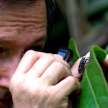Brawn & Brine
Encounter at the End of the World

Brawn and Brine: Encounter at the End of the World
For a biologist, a visit to the Galapagos Islands, some 850 miles west from the coast of Ecuador on the Pacific Ocean, is the trip of a lifetime. It is a destination that fulfills every dream of seeing in the flesh the animals and plants we read about while in college when we learned about Charles Darwin and his voyage on the Beagle. This most famous archipelago is home to dozens of endemic species found nowhere else in the world. The opportunity to observe them and photograph them was the pinnacle of my field career.
Among the unique species in these rugged, volcanic, and arid islands, the marine iguana (Amblyrhynchus cristatus) holds a special place in my biologist's mind. I grew up in the American tropics seeing green iguanas on my father's ranch. To see a relative of the green iguana dive into the ocean, swim with its legs tucked to the side, propelled by its tail, land on the ocean floor, and start grazing on the algae growing on the rocks, is simply spectacular and oh, so strange! In the process of feeding underwater, these iguanas consume quite a volume of saltwater, which somehow, they need to dispose of periodically.
As cold-blooded (or poikilotherms, as the technical name is), the iguanas have to climb out of the cold water and get their body temperature up by sunning on rocks, head up, bodies still. Here is where things get weird. From reading and watching nature documentaries, I knew that the accumulated salt in the iguana's digestive system needed to be excreted somehow. The bizarre method that nature chose for this species was to evolve a set of glands connected to their nostrils that extract the excess salt from their blook and "sneeze" it out as a concentrated brine.
I saw the three sunning iguanas a few meters from the trail and decided to slowly approach them and see if I could capture in a photograph the moment of the sneeze. While I had seen several videos of the trick, I had not seen actual pictures taken at the right moment. I sat down on the sharp edges of the volcanic a couple of feet from the group—which totally ignored me, which was very cool—got my camera ready, and took a couple of photos to gauge exposure. While looking down at the camera, I heard the "sneeze!" and got sprinkled with brine. Well, I missed that one; I'll catch the next. I put the camera to my eyes, focused on the closest individual, and waited…
"Sneeze!" Brine flew all over, and it was so fast that I wasn't even able to snap a shot at all. OK, patience is vital, so I pre-focused again, held the camera steady with the shutter button half-pressed, and…" Sneeze!" This time, the one that got rid of the brine was one of the other two I wasn't focusing on. I got brine on my face and the camera lens, which I quickly cleaned up, while the other two iguanas proceeded to add their sneezes to the set I was not photographing. This definitely wasn't working. My group was already moving on, and the guide was not happy I was separated from them and wanted me to get up and join them. I was determined to get my shot, but I was running out of time.
I realized that I would never be fast enough to press the shutter if I waited for the sneeze. I watched the sunning trio for a while and finally noticed a slight twitch in their bodies barely a second before they sneezed. That was the clue I needed. I focused on the most striking one of the three, ignored the other's sneezes and the impatient calls from my group, and waited for the twitch…As soon as I saw it, I pressed the shutter.
The result is the image I share with you today.
Carlos de la Rosa






Comments
There are no comments for this story
Be the first to respond and start the conversation.